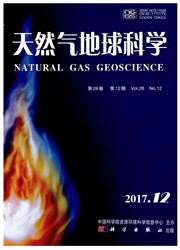

 中文摘要:
中文摘要:
通过对四川盆地含硫天然气中H2S、噻吩、硫醇和氧硫化碳等硫化合物的分析测试,认为四川盆地天然气中H2S来源于原油裂解和TSR,高H2S含量(大于5%)主要是由TSR后期改造造成的。噻吩是烃类在热力作用下分解而形成的,与干酪根类型和TSR后期改造关系不明显。噻吩热稳定性好,在高温度气藏中仍能有效保存。凝析气藏中,大量硫醇类化合物则主要通过热力或热催化作用以及TSR改造形成,而高含H2S(大于15%)可能会抑制硫醇类化合物的形成或者硫醇化合物在高演化条件下发生热分解。氧硫化碳(COS)的形成不同于噻吩和硫醇,主要是SO2在镧催化作用下形成的,且COS可能是H2S形成过程中伴随的中间产物。
 英文摘要:
英文摘要:
By measuring the concentration of the sulfate compounds (i. e HeS,thiophane,thiol,earbonyl sul- fide) in natural gas from Sichuan Basin, H2S was derived from the oil cracking and thermochemical sulfate reduction (TSR),and the high H2S content is related to the alteration of TSR later. The thiophane in natu- ral gas was decomposed from the hydrocarbons under the thermodynamic conditions, and not related with the kerogen types and TSR alteration. The thiophane still exists in the gas reservoirs with high temperature due to its good thermal stability. In the condensate gas reservoirs, the abundant thiol compounds were formed from the hydrocarbons under thermodynamic or thermol-catalytical conditions or TSR alteration. The high H2S content (H2S〉15%) would constrain the formation of the thiol compounds or the thermal decomposition of thiol compounds would be faster than the H2S formation. The carbonyl sulfide (COS) was transferred from the SO2 under the lanthanum catalysis, which was different from the formation of thiophane and thiol. Additionally,the COS was an intermediate product during the H2S formation.
 同期刊论文项目
同期刊论文项目
 同项目期刊论文
同项目期刊论文
 Origin of marine sour natural gas and gas-filling model for the Wolonghe Gas Field,Sichuan Basin, Ch
Origin of marine sour natural gas and gas-filling model for the Wolonghe Gas Field,Sichuan Basin, Ch Presence of carboxylate salts in marine carbonate strata of the Ordos Basin and their impact on hydr
Presence of carboxylate salts in marine carbonate strata of the Ordos Basin and their impact on hydr Thermochemical sulphate reduction (TSR) versus maturation and their effects on hydrogen stable isoto
Thermochemical sulphate reduction (TSR) versus maturation and their effects on hydrogen stable isoto Origin of marine sour natural gas and gas-filling model in the Puguang giant gas field, Sichuan Basi
Origin of marine sour natural gas and gas-filling model in the Puguang giant gas field, Sichuan Basi 期刊信息
期刊信息
